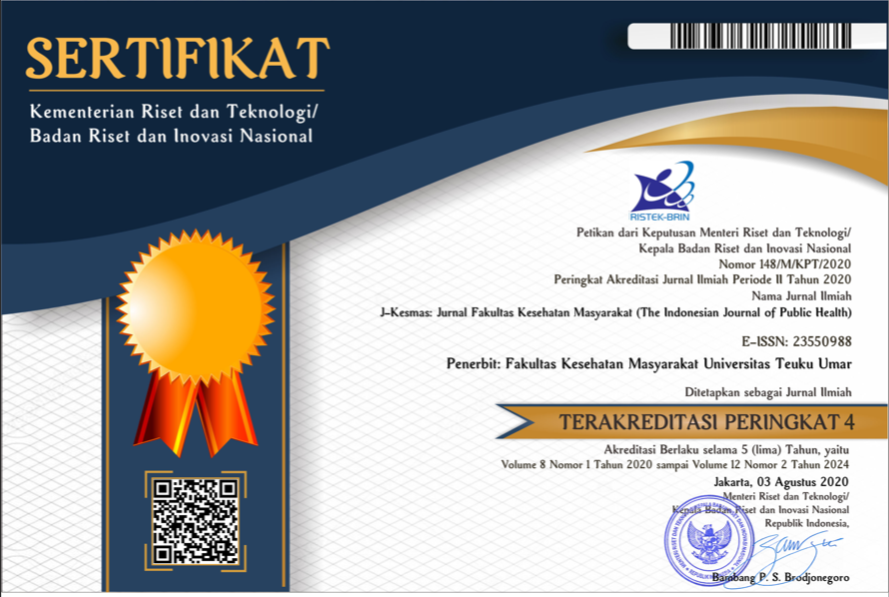Use of Gadgets with Screen Time on Emotional Intelligence in The Digital Era in Middle Adolescence (15-18 Years)
Abstract
Gadget addiction causes various personality disorders. This study is to determine whether the use of gadgets with screen time has an effect on emotional intelligence. This research uses the cross-sectional method. The research variables are gadgets as an independent variable, screen time as an intervening variable, and emotional intelligence as a determining variable. The population of adolescents is the middle adolescence (15-18 years) SMA X Semarang City as many as 252 people. Using a minimum sample of 100 people, with a cluster random sampling technique. Data analysis using Path Analysis. Validity test with a 5% confidence level of 0.374. The calculated r-value > r-table. The reliability test used Cronbach Alpha with the results of the reliability value > 0.7. Research results: (1) The significance value of 0.751 > 0.05 means that the use of gadgets does not affect screen time. (2) The significance value of 0.025 < 0.05 means that the use of gadgets affects emotional intelligence. (3) The significance value of 0.722 > 0.05 means that the use of screen time does not affect emotional intelligence. (4) The direct effect of using gadgets on emotional intelligence is explained by a beta value of 0.228. (5) The indirect effect between gadget use and screen time as an intervening variable is (-0.032 x 0.035 = (-0.00112), so 0.228 > (-0.00112), meaning that screen time is not an intervening variable between gadgets and emotional intelligence. The better a person's emotional intelligence, the better it will be accepted by the community.
Keywords
Full Text:
PDFReferences
Alrasheed, K. B., & Aprianti, M. (2018). Kecanduan Gadget Dan Kaitannya Dengan Kecerdasan Emosi Remaja (Sebuah Studi Pada Siswa Smp Di Kecamatan Setiabudi Jakarta Selatan). Jurnal Sains Psikologi, 7(2), 136–142. http://journal2.um.ac.id/index.php/JSPsi/article/view/5675
Aparna, J., Devi, R. G., & Jyothipriya, A. (2019). Eye complications in children due to excessive use of electronic gadgets. Drug Invention Today, 12(6), 1182–1184.
Azwar, S. (2014). Metode Penelitian, Yogyakarta: Pustaka Pelajar, 2012. Reliabilitas Dan Validitas Edisi, 4.
Badan Pusat Statistik. (2020). Statistik Telekomunikasi Indonesia. Badan Pusat Statistik. https://www.bps.go.id/publication/2021/10/11/e03aca1e6ae93396ee660328/statistik-telekomunikasi-indonesia-2020.html
Berita Kominfo. (2014). 98 Persen Anak dan Remaja Tahu Internet. Kominfo.Go..Id. https://kominfo.go.id/index.php/content/detail/3836/98+Persen+Anak+dan+Remaja+Tahu+Internet/0/berita_satker
Boers, E., Afzali, M. H., & Conrod, P. (2020). Temporal Associations of Screen Time and Anxiety Symptoms Among Adolescents. Canadian Journal of Psychiatry, 65(3), 206–208. https://doi.org/10.1177/0706743719885486
Damanik, R., … E. H.-J. H., & 2019, undefined. (2019). Hubungan Tingkat Kecanduan Gadget Dengan Kecerdasan Emosional Remaja Di Sma Negeri 2 Dolok Sanggul Tahun 2019. 114.7.97.221, 4(1). http://114.7.97.221/index.php/JRH/article/view/1892
Fatima, A., Ansari, S. K., Waqar, H., & Jameel, A. (2021). Determine Augmented Risk Association Between Health Problems and Screen Exposure to Electronic Gadgets in University Students, Islamabad During COVID-19 Pandemic. Science Publishing Group, 2(2), 22–26. http://www.sciencepublishinggroup.com/j/innov
Feby. (2021). Mengetahui Screen Time Penggunaan Gadget. Gramedia. https://www.gramedia.com/literasi/mengetahui-screen-time-penggunaan-gadget/
Gandhi, N., Wedanthi, P. H., & Alfinuha, S. (2021). Pelatihan Emotional Intelligence untuk Meningkatkan Kemampuan Manajemen Konflik Pada Siswa SMA. Journal An-Nafs: Kajian Penelitian Psikologi, 6(2), 165–178. https://doi.org/10.33367/psi.v6i2.1465
Ganne, P., Najeeb, S., Chaitanya, G., Sharma, A., & Krishnappa, N. C. (2021). Digital Eye Strain Epidemic amid COVID-19 Pandemic–A Cross-sectional Survey. Ophthalmic Epidemiology, 28(4), 285–292. https://doi.org/10.1080/09286586.2020.1862243
Kementerian Kesehatan Republik Indonesia. (2017). Ini Tiga Motif Anak Menggunakan Internet. https://sehatnegeriku.kemkes.go.id/baca/umum/20170725/0221800/tiga-motif-anak-menggunakan-internet/
Kumar, A. K., & Sherkhane, M. S. (2018). Assessment of gadgets addiction and its impact on health among undergraduates. International Journal Of Community Medicine And Public Health, 5(8), 3624. https://doi.org/10.18203/2394-6040.ijcmph20183109
Nisha, R., & Alice Sophia, D. (2017). Parents role in nurturing emotional intelligence in children life – An approach towards development of emotional quotient. In International Journal of Economic Research (Vol. 14, Issue 11, pp. 151–158). Serials Publications.
Ozturk Eyimaya, A., & Yalçin Irmak, A. (2021). Relationship between parenting practices and children’s screen time during the COVID-19 Pandemic in Turkey. Journal of Pediatric Nursing, 56, 24–29. https://doi.org/10.1016/j.pedn.2020.10.002
Ratri Desiningrum, D., Indriana, Y., & Siswati. (2017). Intensi penggunaan gadget dan kecerdasan emosional pada remaja awal. Prosiding Temu Ilmiah X Ikatan Psikologi Perkembangan Indonesia, 1, 65–71. http://garuda.ristekbrin.go.id/documents/detail/497874
Sarla, G. S. (2020). Excessive use of electronic gadgets: health effects. The Egyptian Journal of Internal Medicine 2020 31:4, 31(4), 408–411. https://ejim.springeropen.com/articles/10.4103/ejim.ejim_56_19
Sianturi, Y. R. U. (2021). Pengaruh Penggunaan Gadget terhadap kemampuan Interaksi Sosial Siswa Sekolah Dasar. Jurnal Kewarganegaraan, 5(1), 276–284. https://doi.org/10.31316/jk.v5i1.1430
Small, G. W., Lee, J., Kaufman, A., Jalil, J., Siddarth, P., Gaddipati, H., Moody, T. D., & Bookheimer, S. Y. (2020). Brain health consequences of digital technology use. Dialogues in Clinical Neuroscience, 22(2), 179–187. https://doi.org/10.31887/DCNS.2020.22.2/gsmall
Sultana, A., Tasnim, S., Hossain, M. M., Bhattacharya, S., & Purohit, N. (2021). Digital screen time during the COVID-19 pandemic: a public health concern. In F1000Research (Vol. 10, pp. 1–8). F1000 Research Ltd. https://doi.org/10.12688/F1000RESEARCH.50880.1
Wolff, K., RJohnson, R., & Saavedra, A. (2013). Fitzpatrick Color Atlas And Synopsis Of Dermatology. McGraw-Hill Companies.
Zakiyuddin, Z., Reynaldi, F., Luthfi, F., Sriwahyuni, S., & Ilhamsyah, F. (2020). Dampak Gadget pada Anak Usia Remaja di SMP Negeri 02 Meureubo Kecamatan Meureubo Kabupaten Aceh Barat. Jurnal Pengabdian Masyarakat: Darma Bakti Teuku Umar, 2(1), 161. https://doi.org/10.35308/baktiku.v2i1.1978
DOI: https://doi.org/10.35308/j-kesmas.v9i2.6028
Refbacks
- There are currently no refbacks.
Managed by Fakultas Kesehatan Masyarakat
Published by Universitas Teuku Umar
Website: http://jurnal.utu.ac.id/jkesmas
Email: jkemas@utu.ac.id 
This work is licensed under a Creative Commons Attribution-ShareAlike 4.0 International License.







.jpg)


